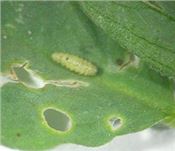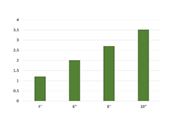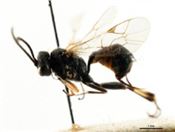Alfalfa Weevil Feeding Underway – Injury Potential Is A Numbers Game
DR. LEE TOWNSEND
LEXINGTON, KY.
Alfalfa weevil is the major insect pest of the first alfalfa cutting. Kentucky’s mild winter has pushed development significantly ahead so feeding by weevil larvae is appearing early. The February 21, 2017 issue of KPN provided a look at the rapid accumulation of degreedays compared to the previous year. The threat has not diminished.
The tiny pinholes chewed into tip leaves by 1st and 2nd stage larvae are easy to overlook (Figure 1). The real damage comes a few days later as the 3rd and 4th stages feed voraciously. Individual larvae feed for about 3 weeks, but eggs hatch over an extended period, so damage can continue for 5 to 6 weeks. All fields that have been established for 2 years or longer will have weevils; the important question is: “Are there enough weevils to affect yield and quality?”
Assessing Weevil Populations
A careful assessment of the weevil population is key to making a sound management decision. The alfalfa weevil sampling program provides an assessment plan to follow (see EntFact-127). The big factors are plant height (inches) and numbers of larvae per 30 stems. Growing alfalfa plants can tolerate a moderate amount of feeding by weevil larvae without harm; however, a lower number of larvae per stem can cause yield and quality loss on short plants that are growing slowly (Figure 2). That may be the case in a significant number of fields this spring.
Evaluate each alfalfa field separately because weevil numbers can vary from field to field. Feeding damage should appear earlier on south-facing slopes where weevil development is accelerated. Large numbers of weevil larvae on short alfalfa is a recipe for serious problems.
Management with Insecticides
A range of insecticides are labeled for alfalfa weevil control (refer to Insecticide Recommendations for Alfalfa, Clover, and Pastures – 2017, Ent-17). Should treatment be warranted, the degree day sampling plan provides recommendations on the need for residual control. In general, higher rates provide extended residual control that can be needed for early season applications. Low rates provide adequate control later in the weevil season and may have shorter harvest intervals.
While insecticide applications can be valuable in reducing damage to the alfalfa weevil, unnecessary treatments can have some significant environmental impacts on pollinators and natural enemies of the weevil. Purple deadnettle, chickweed, and dandelion are among the important early sources of nectar and pollen for honey bees. Avoid applications where bees are actively foraging.
Application tips
Check product labels for requirements on buffer zones between field edges and aquatic habitats.
Review wind speed limits on labels and determine wind direction before application. Some labels have specific requirements to reduce the potential for pesticide drift; others have only short, broad statements. Many products indicate a spray envelope of 3 to 10 miles per hour (mph) while others may list 15 mph as a maximum speed. In general, wind speed cannot be estimated accurately. Do not spray if conditions will cause drift to non-target areas. You can get a general idea of current spraying conditions at UKAWC Current U.S. Spraying Conditions; however, your local situation may be very different.
Biological Control
Two small (0.1-inch long), non-stinging wasps that attack alfalfa weevil have become established across the U.S. as important biological control agents. They occur in Kentucky alfalfa fields and play an important role in regulating weevil populations during most seasons. The wasps insert their eggs into small alfalfa weevil larvae so they, too, are active early. Unneeded insecticide applications can disrupt their impact on weevil management. ∆
DR. LEE TOWNSEND: Extension Entomologist, University of Kentucky

Figure 1. Pinhole feeding and a small alfalfa weevil larva seen last week in Fayette County.

Figure 2. Treatment guideline (number of weevil larvae vs plant height). Taller,
rapidly growing plants can tolerate heavier weevil loads.

Figure 3. Alfalfa weevil parasitoid.